Description
- Sun Tracking Solar Panel: WETOWN design handle is built-in LIGHT INTENSITY SENSOR can detect the sunshine intensity, helps users to adjust the direction and angle of this Portable Solar Panels.
- High Energy Conversion Efficiency: Foldable Solar Panel SP100W is made of Monocrystalline Silicon solar cells, which generate energy from the sunlight at high conversion efficiency up to 23.4%.
- XT30 Parallel Plugs: Consider of the difficulties to parallel solar panels via traditional MC4 connectors.(you need program and components). WETOWN issues the plug & play XT30 parallel ports in the handle, you can connect maximum 2*SP100W Solar Panels to build a 200W output system.
- Functional 6+2 Outlets Solar Charger: 18.4V DC5521(Max 5A), XT60(10A), 2*XT30(10A), QC3.0 USB & TYPE-C(5V/3A, 12V/1.5A, 18V/1A), attach with spliter cable DC5521 to Anderson & DC7909. Compated to Jackery/Ecoflow/Bluetti/Goal Zero/Anker Power Stations, charging your phones, Pad, cameras, mini fridge. etc.
- Portable Solar Panel Kit: 23.6*15.3*1.38in (Fold), 48.8×23.6in (Expand), 10±0.2lbs. ETFE Laminated Solar Panel, IP67 Waterproof & Dustproof, operation temperture: -4 to 140°F. Convenience to bring it anywhere to enjoy the sunshine.
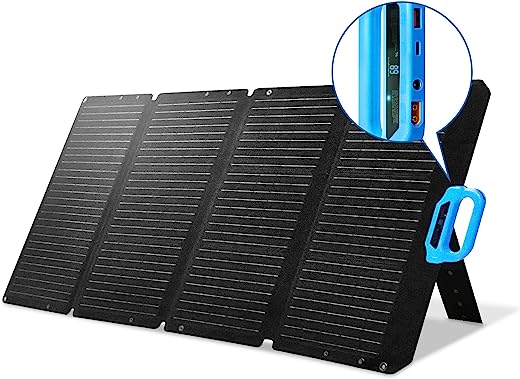
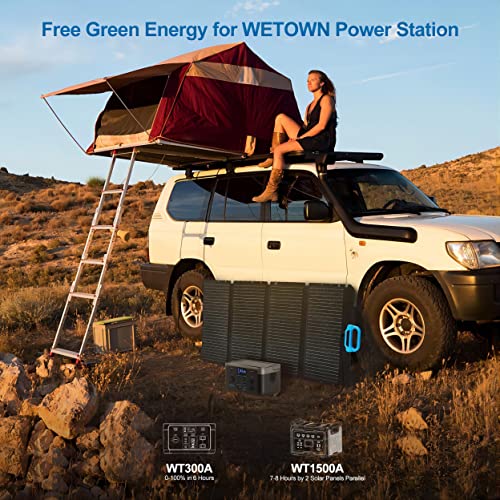
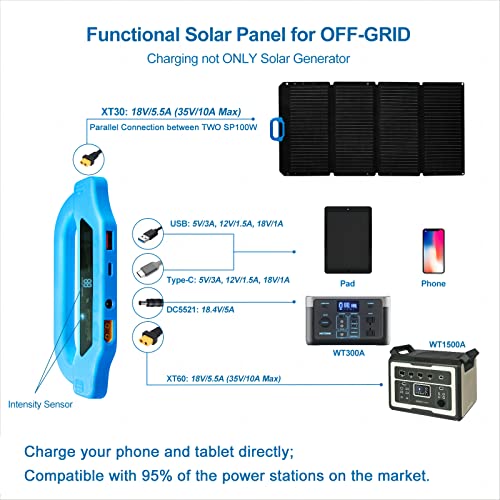
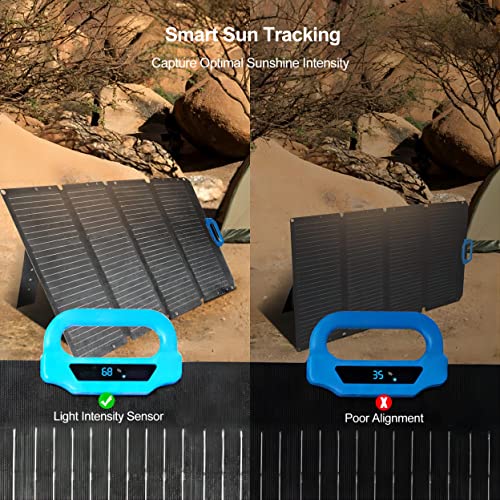

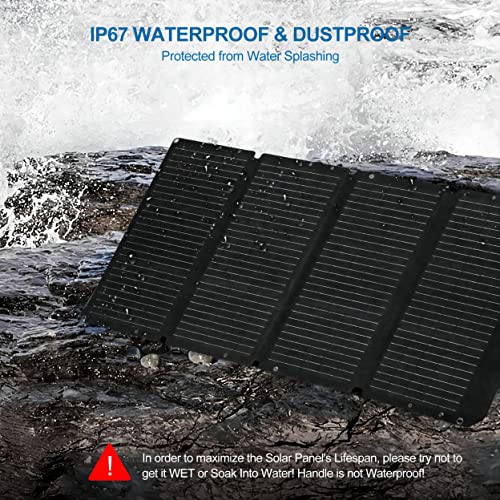
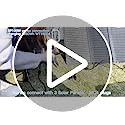
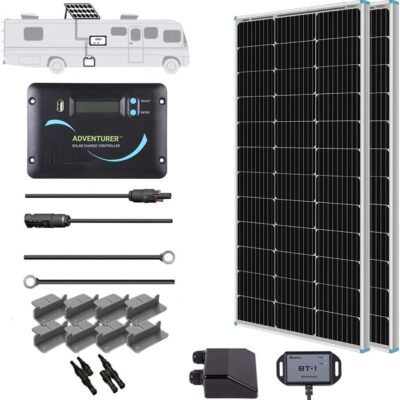
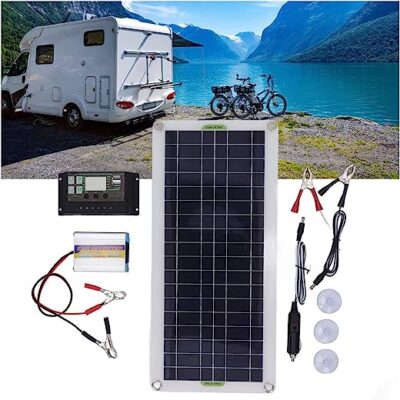
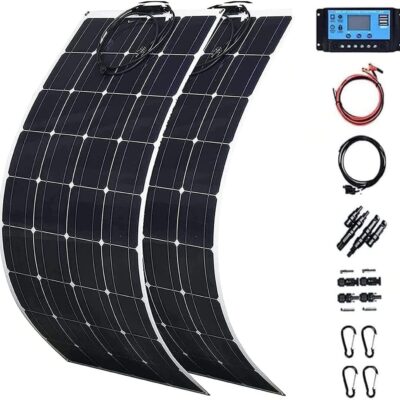
✨ H A P P Y 💖 S H O P P E R ✨ ✌😊 –
Its perfect for us and work very well! Love all of the features and is great for our camping trips but also at home as we have now been using instead of generator for back up power.
✨ H A P P Y 💖 S H O P P E R ✨ ✌😊 –
Test out any ports you may want to use when you get it. I brought a usb-c cable to charge my power station with this panel instead of the bulkier dc cable. At the campsite I find out the usb-c port is off center and I can’t plug into it because of the casing in the way. Of course I find this out a month past the one month return window. Other than that seems to be a good panel. Easy enough to adjust, gets good sun strength. Just learn from me and check everything out when you get it.
randen –
I’ll stat with a few but silly shortcomings that jump right out.
No cable storage pocket! That’s just silly. Having to pack connection cables with the power station is not a big deal, but going out on a trip while forgetting a power cable for the solar panel would be a total fail.
Cable connection angle. Due to integration of connector sockets into the carry handle, connector sockets are facing towards the main panel, causing cables to cast shadow on the panel, but what’s worse it forces tension stresses on both cables and connector sockets.
While small amount of shading onto the panel can be overlooked, stressing cables and sockets usually ends in physical failure of both.
A very simple solution would be to include cables with L-shaped connectors to make 90 degree connections.
Now for a whole bunch of positives.
Form factor!
In portable solar panel category it’s a big one. I’ve tried other portable panels like Rockpals and Elecaenta, and this WETOWN SP100W panel has by far the best portable form factor design.
Instead of a wide form factor of most portable panels, folding WETOWN panels are taller rather then wider.
That’s made possible by use of semi-rigid materials for panel backing and the most reasonable kickstand design I’ve came across.
The problem with most semi-flexible folding panels is that they have a lot of flex when they are unfolded and set up. That’s why their form factor usually has to be wider rather then taller.
The first benefit of semi-rigid tall form factor is ease of packing/transportation and ease of set up.
Unlike semi-flex folding panels WETOWN sets up in one go, just unfold, set, and adjust kickstands as needed, while since semi-flex panels are longer they flop around, and require multiple actions to properly set them up.
Other then semi-rigid materials what really helps set up is the design of fasteners. Instead of the usual velcro and plastic buckles, WETOWN uses button snaps both for securing folded panels, for kick stands and their height adjustment.
With other panels be it velcro or plastic buckles, first the panel has to be placed out on the ground, then unfolded one panel fold at a time, then placed upright to unfold the kick stands. WETOWN panel is set up from a standing position since button snaps are easily snapped open, and kick stands can be adjusted from the same position.
Set up might sound like a trivial matter but it could be a pain. Shorter kickstands of other panels not only fail to provide a full range of panel angles, but during setup they often fold back onto the panel forcing the user to start the set up process from th beginning.
Another big set up factor is weather conditions. With shorter kick stands that are not secured by guide straps, a light gust of wind can easily knock over a semi-flex panel.
I’ve had that happen with both Rockpals and Elecaenta panels, but WETOWN is very sturdy and much less susceptible to wind gusts.
In similar form factor size, sturdier materials play a big role in durability vs. weight, and this is where WETOWN solution really comes ahead.
I’ve compared four panels; Rockpals SP003, Rockpals RP100, Elecaenta 120W, and WETOWN SP100W.
Rockpals SP003 is the only 100W panel out of the bunch that’s actually portable for take along carry. All other panels are too heavy for take along carry, but this is where durability, panel output and form factor features play a decisive role.
To get that carry along portability, Rockpals SP003 is the most basic panel with no kick stands, and thin, very flexible panels that have no ETFE coating, which is a big deal for portable panels.
Those two shortcomings alone make SP003 not very useful even though it could be comfortably carried, because lack of kickstands remove ability to adjust for sun position, while lack of ETFE coating drastically cuts durability and life cycle of the panels.
Rockpals improved RP100 panel does have short length kick stands, panels do have ETFE coating, but while the form factor is smaller then SP003, the total weight is almost twice as much, while the output is about 10-15 watts less then of the SP003, thus negating all the benefits of the smaller form factor.
In standard semi-flexible form factor it’s ELECAENTA panel that really stands out. It has the highest average power output of all four panels, it comes with usable length kickstands, but it is the heaviest of the four and it can be a handful while setting up.
This is where power output of these folding panels matters and why in overall usability WETOWN comes on top.
The panel with highest average output is Elecaenta, followed by a tie between Rockpals SP003 and WETOWN, with Rockpals RP100 being last.
Since Rockpals SP003 had to be used while propping it up against another panel that had kick stands, even with good output SP003 does not make the cut, and since Rockpals RP100 gave the least amount of output, the remaining competing panels are WETOWN SP100W and Elecaenta 120W.
After testing both of these panels it comes down to Elecaenta 120W panel providing on average 10-15 more watts then WETOWN 100W panel, but it’s the details that matter.
WETWON sun intensity indicator is very handy when there is a need to quickly find optimum angle of the panel towards position of the sun. It really works well and fast especially after getting used to optimum angles.
In a head to head output comparison between Elecaenta and WETOWN panels, the major difference is in Open Circuit Voltage, which is important for two main reasons. First is compatibility with input of your power station, and then panel efficiency at low sun output.
WETOWN Open Circuit Voltage is a set 21.5V, while Elecaenta is a range between 23V and 25V
As measured, at indicated 70% solar intensity, WETOWN panel voltage was 17.8V with charging power output of 51 watts, so in 18 volt range the output is around 50 to 55 watts. At the same time Elecaetna panel measures 20.7V under load while producing 57 watts and at 21.3V producing 61-63 watts.
In similar voltage range under load, Elecaenta panel outproduces WETOWN by roughly 10 watts, but I did run into an issue with Elecaenta panel voltage output when not under load, which was higher then 23.5V. Such voltage can trip input limit cut off in some power stations.
Overall, due to higher voltage range 120W Elecaenta panel provides better output at lower sun intensity and during shading, but this is where scalable WETOWN SP100W design takes the lead.
When shading and overcast is an issue, the only effective way to overcome low output is running multiple panels, and WETOWN scalable design is a step ahead of the standard parallel cabling designs.
While both Rockpals and Elecaenta panels require Y Branch Parallel Adapter cables, WETOWN comes with specific XT30 type parallel conection sockets and cables.
At first I thought that the power cable WETOWN came with is on the short side, but after setting up the panel it became obvious that superior form factor easily allows for a shorter cable, while specific XT30 parallel cabling allows for easy scalability without the fuss of flimsy semi-flexible format of traditional folding panels.
What sets WETOWN even further apart is the ability of XT30 parallel socket to set up up to three SP100W panels in very close proximity to each other, while traditional semi-flex panels are limited to two panels in parallel while requiring extra space and extra length (and weight) of cable.
This is where WETOWN design really outshines traditional folding panels, truly portable form factor and integrated XT30 connectors that allow unmatched scalability.
In a head to head comparison of a single panel and given the same price point, it really is a toss up between higher average power output of heavier and less feature rich Elecaenta 120W panel verses what is clearly a next generation design of WETOWN SP100W.
Yet as soon as dependable, long lasting scalability with minimum amount of set up time becomes necessary, WETOWN is a clear winner.
Now I’m really curious as to how three highly portable WETOWN SP100W panels run in parallel would compare to a bulky pair of 200 Watt panels of the competition.
randen –
The media could not be loaded.
The contents of the box I received include a 100 watt portable and foldable solar panel, an XT60 to XT60 cable, an XT30 to XT30 parallel cable, and a DC5521 to DC5521+DC7909+Anderson cable.
I bought it to have a more or less reliable source of energy for my mobile devices, my modem and, if weather permits, even my laptop during a long power outage after a hurricane or any other disaster. I bought two power stations before Ian. However, that wasn’t enough to power my phones, tablets and laptop through more than a week without power. Hopefully through a next disaster, I can charge my two portable power stations with it and have enough saved energy.
I did not have to buy any extra cable as the solar panel already comes with a DC5521 extender which I need to charge my two power stations – each a different brand but both use the same cable. My plan was and is to charge one power station while I’m using the other and vice versa. That seems to work out for me as the sun in South Florida is intense enough for solar charging year-round, even during winter.
The solar panel comes with a blue handle where the ports are. That’s handy to have them all at the same location. However, the ports are facing inwards the panel so the cables may cast a tiny shadow on the solar panel if I don’t bend them. There are two XT30 parallel ports, one standard USB port and one USB-C port, each compatible with different voltage and amps combinations, DC5521 port, and one XT60 port. Concerning the XT30 parallel ports, these ports are on the right and left side of the handle.
Folded out, the solar panel measures almost 49 inches in length and is over 23 inches wide. The solar panel consists of four sub-panels. When I fold it all back in, the size is reduced to 23.6 inches by 15.3 inches.
To charge my battery, I use the light intensity sensor as my guide and the three kickstands on the back to adjust position and angle of the panel. Then I use the DC5521 cable to connect it to one of my 300 watts power stations. I can also use the USB ports to charge any mobile devices or batteries simultaneously. Most of the time, I prefer to charge only a power station.
Even though it says it’s waterproof, the ports are exposed to the elements. So I take care I don’t get surprised by sudden rainfall and bring it inside when rain is approaching.
The efficiency of the solar panel is enough for me as it can fully charge one 300 Wh power station battery in less than 6 hours during a sunny day. It means I can use, as I planned, one power station while the other is charging. And even if I don’t have the solar panel in an optimal position and the light intensity detector tells me it’s only 1%, I still get 50 watts output. I have been using it regularly almost every other weekend for three months to see how fast it can charge each of my power stations on average. The panel was able to always fully charge one power station within daylight whenever it was sunny and with a few to no clouds.
In the end, my new solar panel is capable of fully charging at least one power station during daylight which is more than enough to power my mobile devices and to use my laptop for a one or two hours daily in case a hurricane like Ian causes a long outage again.